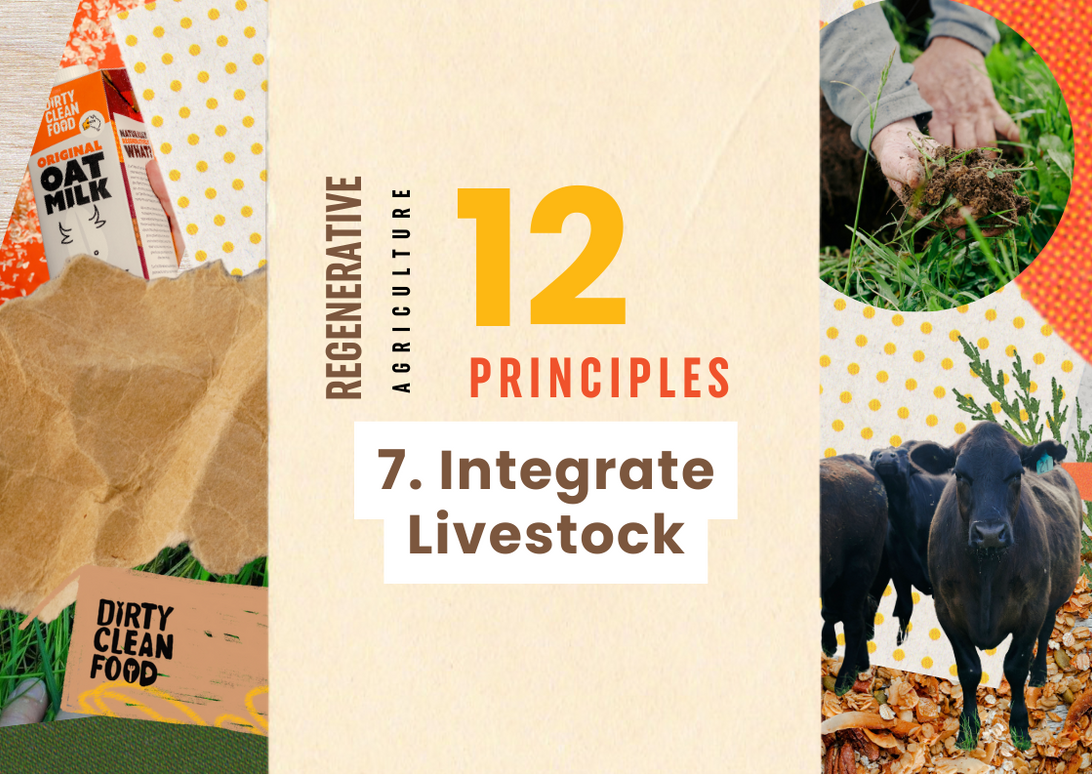
Regen Ag #7- Integrate Livestock
|
Time to read 4 min
|
Time to read 4 min
Welcome to our 12 Principles of Regenerative Agriculture series- where we define "regen ag" and show you how regenerative farming changes the planet, the system, and our food.
Regenerative agriculture seeks to restore and enhance ecosystems by working with natural systems rather than against them. Central to this approach is the idea that healthy soil is the foundation of a productive and resilient farm. Livestock play a crucial role in building and maintaining soil health through their grazing and manure deposition.
Conventional set stocking is the practise of keeping a set number of livestock in one area all the time. This practice leads to overgrazing of plants, where the livestock will repeatedly graze the same plants over and over, until those plants no longer have enough energy reserves to grow back. Because they are selectively grazing, the pasture composition changes to favour less palatable plants, which in turn reduces the diversity and nutrient content of the pasture.
The animals can end up with parasite loads, meaning they will get a buildup of worms, lice, and other parasitic organisms, because the conditions have been created for them to multiply. Grazing animals over the same area all the time means they will pick up parasites, such as worms, from their own manure. This leads to an increased need to treat animals with drenchers, wormers, and other chemicals to control these parasites.
Holistic planned grazing, or high-density rotational grazing, mimics natural grazing patterns of large herds of herbivores in the wild. In these natural systems, the animals bunch together tightly in large groups, kept together by the predatory pressure of animals such as wolves and lions. This pressure means that they eat everything in their path, and don't return to an area for an extended period of time, until the pasture has renewed itself to the point it can support another grazing. Check out this video on how wolves changed rivers in the Yellowstone National Park!
Regenerative farmers replicate this pattern by moving their animals onto fresh pasture regularly, then moving them onto the next area, giving the pasture as long as possible to regenerate or recover between grazings. When moved in large enough mobs, the animals will non-selectively graze – eating the same amount of all the plants. This prevents overgrazing, while encouraging the growth of diverse plant species, which in turn supports a wide range of insects, birds, and other wildlife. Farmers watch carefully to move livestock on before too much pasture is eaten, so that groundcover is always maintained. Over time, the productivity of the pasture improves with this kind of management, as the increased levels of soil carbon help to store more water and nutrients.
One of the key benefits of integrating livestock into farming systems is their ability to improve soil fertility. Grazing animals such as cows, sheep, and goats help to break up compacted soil, promote the growth of diverse plant species, and cycle nutrients through their manure. This natural fertilization not only reduces the need for synthetic inputs but also enhances the soil's capacity to retain water and sequester carbon—a vital tool in the fight against climate change. These animals can have hugely beneficial impacts on pasture, but when poorly managed, can cause bigger problems. The key to integrating livestock into a regenerative farming system is how the animals are managed.
Integrating livestock into farming systems also offers economic benefits for farmers. By diversifying their operations to include both crops and livestock, farmers can spread their financial risk and increase their resilience to market fluctuations. Livestock can also provide an additional source of income through the sale of meat, dairy, and other animal products.
Moreover, livestock can serve as valuable partners in pest and weed management. For example, chickens can be used to control insect pests in orchards and vineyards, while goats are excellent at clearing brush and weeds in pasture and forested areas. By harnessing the natural behaviours of these animals, farmers can reduce their reliance on chemical pesticides and herbicides, thereby minimising their environmental impact.
In addition to their role in soil health and pest management, livestock can also contribute to the overall sustainability of farming systems by closing nutrient loops. By feeding livestock on-farm-grown feed and utilizing their manure as fertilizer, farmers can reduce the need for imported inputs and minimize nutrient runoff into waterways.
Kent, Warren and Ian all rotate their cattle throughout their pasture to promote the growth of annual and perennial forbes and grasses.
Blythe also added egg laying chickens into her rotation with the cattle, where they add a different manure to the pasture, and have different grazing and foraging benefits that complement the cattle.
Col moves his sheep in a similar way, where his sheep are ideally suited to the steeper slopes at green Range.
Sam and Ewen use mobile chicken chalets for their meat birds, which provide more protection for the chickens form the elements and from predators, which providing very dense grazing on the pasture to optimize the effect the chickens can have on regenerating their pasture.
Steve and Jamie use sheep in their cropping rotation, adding pasture phases that improve soil health, whilst utilizing sheep to clean up weeds, spilt lupins and extra stubble.
It's essential to recognize that successful integration of livestock into farming systems requires careful planning and management. Farmers must consider factors such as animal welfare, grazing patterns, and herd health to ensure the well-being of both the animals and the environment.
Integrating livestock into farming systems is a fundamental principle of regenerative agriculture with numerous benefits for soil health, biodiversity, farmer livelihoods, and ecosystem resilience. By harnessing the natural behaviors of animals and working in harmony with nature, farmers can create more sustainable and resilient food systems for future generations.
‘Regenerative agriculture is an ecological approach to farming that allows landscapes to renew themselves.’







